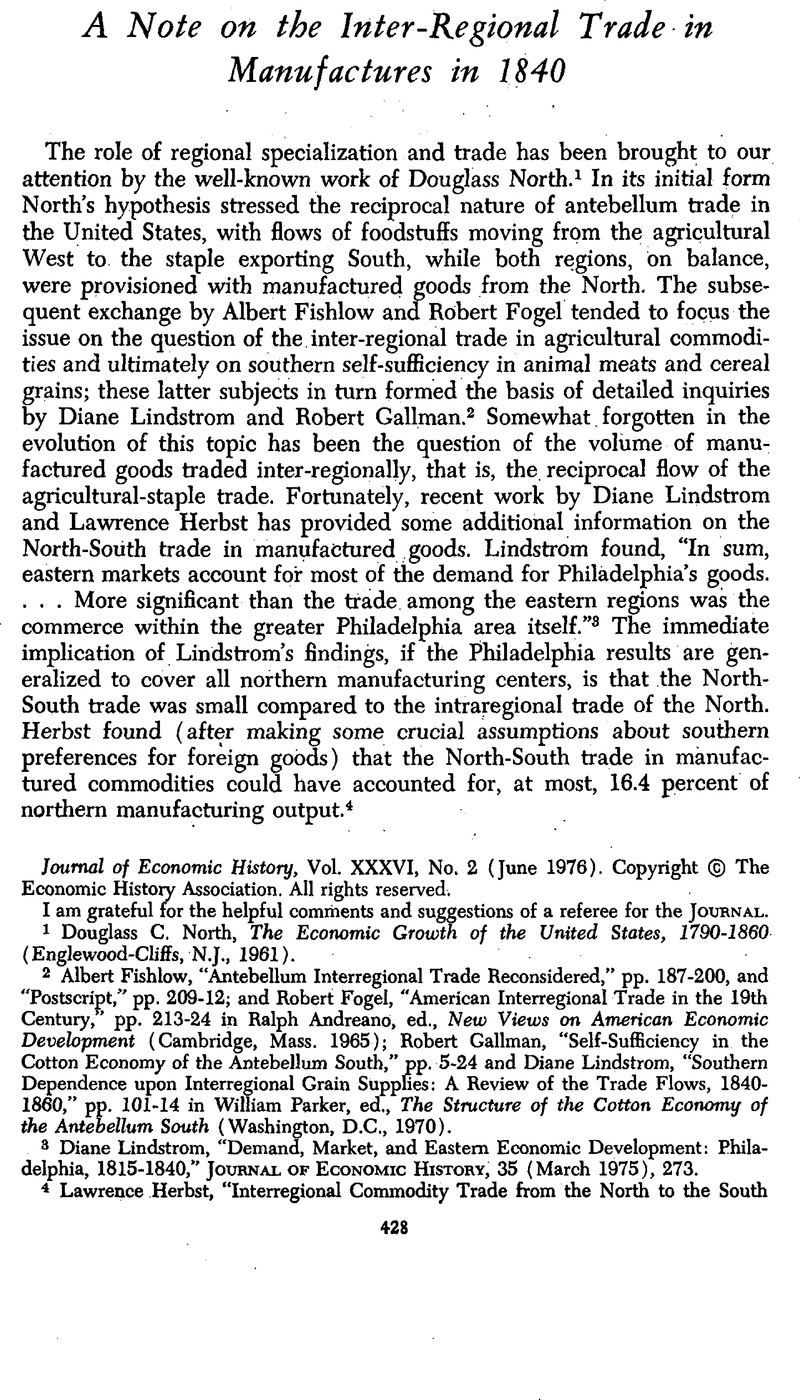Published online by Cambridge University Press: 11 May 2010

1 North, Douglass C., The Economic Growth of the United States, 1790–1860 (Englewood-Cliffs, N.J., 1961)Google Scholar.
2 Albert Fishlow, “Antebellum Interregional Trade Reconsidered,” pp. 187–200, and “Postscript,” pp. 209–12; and Robert Fogel, “American Interregional Trade in the 19th Century,” pp. 213–24 in Andreano, Ralph, ed., New Views on American Economic Development (Cambridge, Mass. 1965)Google Scholar; Robert Gallman, “Self-Sufficiency in the Cotton Economy of the Antebellum South,” pp. 5–24 and Lindstrom, Diane, “Southern Dependence upon Interregional Grain Supplies: A Review of the Trade Flows, 1840–1860,” pp. 101–14 in Parker, William, ed., The Structure of the Cotton Economy of the Antebellum South (Washington, D.C., 1970)Google Scholar.
3 Lindstrom, Diane, “Demand, Market, and Eastern Economic Development: Philadelphia, 1815–1840,” Journal of Economic History, 35 (March 1975), 273CrossRefGoogle Scholar.
4 Herbst, Lawrence, “Interregional Commodity Trade from the North to the South and American Economic Development in the Antebellum Period,” Journal of Economic History, 35 (March 1975), 266–7.CrossRefGoogle Scholar
5 Fishlow, Albert, American Railroads and the Transformation of the American Economy (Cambridge, Mass., 1965), pp. 262–98.Google Scholar
6 Ibid., p. 275.
7 Ibid.
8 The figures in the text must be viewed as upperbound estimates of the volume of inter-regional trade in manufactures in 1840, since there is no basis in fact or theory to suppose that the APCm in the North was less than the APCm in the other regions. On the contrary, because of an early start in manufacturing and more diversified economic activity in the North than, say, in the South we should expect that the North would have a higher propensity, on average, to consume manufactures. If the calculation were made to reflect this, the total trade volume between the two regions would be less than $67 million. Hence, the basis of the calculation in Table 2, which allows the APC's in the East and South to be equal forms a plausible upperbound of the inter-regional trade. Another factor that might tend to impart an upward bias in the inter-regional trade estimates of Table 2 is the argument often advanced in the narrative literature of the South stressing the southern preference for foreign goods, especially the luxury good consumption of the planter class. It is one thing, however, to infer that the planter class had a high import propensity, it is quite another to suggest that this alone would imply that the average propensity of the South as a whole to consume foreign imports was higher than that of the North. Although both Gallman's, Robert, “Trends in the Size Distribution of Wealth in the Nineteenth Century: Some Speculations,” in Soltow, Lee, ed., Six Papers on the Size Distribution of Wealth and Income (NBER, Studies in Income and Wealth, 33 [New York, 1969])Google Scholar and Wright's, Gavin “‘Economic Democracy’ and the Concentration of Agricultural Wealth in the Cotton South, 1850–1860,” in Parker, William, ed., The Structure of the Cotton Economy of the Antebellum South (Washington, D.C.: Agricultural History Society, 1970Google Scholar) provide interesting information on the size distribution of income and wealth in the Antebellum South compared to the North, it would be hazardous to infer anything about northern and southern propensities to import foreign commodities on the basis of available evidence. The issue of the likely propensity of the South to import foreign commodities vis à vis the North is of interest, because in Section III, the southern import capacity for northern manufactures is calculated as a residual measure, that is, total import capacity minus purchases of western foodstuffs and direct imports of foreign commodities other than finished manufactures.
9 North, Douglas, The Economic Growth of the United States, 1790–1860 (Englewood Cliffs, N.J., 1961)Google Scholar, Appendix I, Table A-VIII, p. 233 (cotton exports), and Appendix III, Table IV, p. 283 (average annual tobacco exports for the decade 1830–1840).
10 Albert Fishlow, American Railroads, p. 274, Table 35, calculated the southern export potential in 1860. For that year Fisnlow shows that rice, naval stores, sugar, and molasses accounted for approximately 5 percent of southern exports. The procedure used here for calculating the southern import capacity in 1840 follows that of Fishlow, ibid., 269–75.
11 The purchase of western foodstuffs by the South is estimated from Tables 36 and 39 in Fishlow, American Railroads, that is, by applying the fraction of western foodstuffs consumed in the South to the total receipts of western products. Specie and foreign commodity imports to the South in 1840 are estimated by scaling down Fishlow's 1860 estimates by the ratios of total imports of those items for the respective years.
12 It should be noted, however, that this result assumes that none of the $7.6 million of machinery or $5.6 million of ships produced in the North were sold in the South. For example, Temin, Peter, “Steam and Water Power in the Early Nineteenth Century,” Journal of Economic History, 26 (June 1966), Table I, p. 191CrossRefGoogle Scholar, found that of the 206 engines reported in the South in 1838 only 57 had been erected by southern builders. Clearly some northern machinery and ships were sold to the South in 1840.